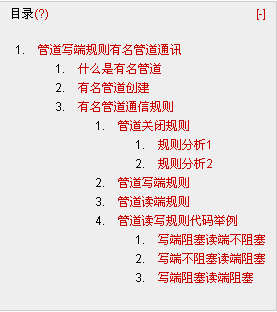Linux学习记录--有名管道通信
有名管道通讯
什么是有名管道
匿名管道应用的一个重大限制是它没有名字,因此,只能用于具有亲缘关系的进程间通信,在有名管道(named pipe或FIFO)提出后,该限制得到了克服。FIFO不同于管道之处在于它提供一个路径名与之关联,以FIFO的文件形式存在于文件系统中。这样,即使与FIFO的创建进程不存在亲缘关系的进程,只要可以访问该路径,就能够彼此通过FIFO相互通信
有名管道创建
int mkfifo(const char * pathname, mode_t mode)
和普通文件创建一样pathname为文件名称,mode为权限
有名管道通信规则
管道关闭规则
int close (int __fd);
1.当最后一个读进程管道关闭时,写进程无论是阻塞还是非阻塞,都会将管道写满(如果能写满)并退出
2.当最后一个写进程管道关闭时,向管道写入一个结束标识,当读进程从管道读到这个结束标识时,如果是阻塞读进程将结束阻塞返回读入数据个数为0.(对于未阻塞读进程如果管道内没有数据则返回-1,如果读到结束标识则返回读入数据个数为0)
规则分析1
写进程
#include<unistd.h>
#include<stdlib.h>
#include<stdio.h>
#include<string.h>
#include<fcntl.h>
#include<limits.h>
#include<sys/types.h>
#include<sys/stat.h>
#include<errno.h>
#define FIFO_NAME "/tmp/my_fifo"
#define BUF_SIZE 80000
intmain(int argc, char *argv[]) {
unlink(FIFO_NAME);
int pipe_fd;
int res;
char buf[BUF_SIZE];
memset(buf, 3, BUF_SIZE);
if (access(FIFO_NAME, F_OK) == -1) {
res = mkfifo(FIFO_NAME, 0766);
if (res != 0) {
fprintf(stderr, "不能创建管道文件 %s\n", FIFO_NAME);
exit(1);
}
}
printf("进程PID %d 打开管道 O_WRONLY\n", getpid());
pipe_fd = open(FIFO_NAME, O_WRONLY);
if (pipe_fd != -1) {
res = write(pipe_fd, buf, sizeof(buf));
printf("写入数据的大小是%d \n", res);
close(pipe_fd);
sleep(1000);
} else
exit(1);
exit(1);
}
读进程
#include<unistd.h>
#include<stdlib.h>
#include<stdio.h>
#include<string.h>
#include<fcntl.h>
#include<limits.h>
#include<sys/types.h>
#include<sys/stat.h>
#define FIFO_NAME "/tmp/my_fifo"
#define BUF_SIZE 20
intmain(int argc, char *argv[]) {
char buf[BUF_SIZE];
memset(buf, 0, BUF_SIZE);
int pipe_fd;
int res;
int bytes_read = 0;
printf("进程PID %d 打开管道 O_RDONLY\n", getpid());
pipe_fd = open(FIFO_NAME, O_RDONLY);
if (pipe_fd != -1) {
bytes_read = read(pipe_fd, buf, sizeof(buf));
printf("读入数据的大小是%d \n", bytes_read);
sleep(10);
close(pipe_fd);
} else
exit(1);
exit(1);
}
控制台信息
读进程:
进程PID 10930打开管道 O_RDONLY
读入数据的大小是20
写进程:
进程PID 10918打开管道 O_WRONLY
(10S后输出…..)
写入数据的大小是65536
分析:当读进程执行到close(pipe_fd);时,写进程一次性将数据写满缓冲区(65536)并退出。
规则分析2
写进程
#define FIFO_NAME "/tmp/my_fifo"
#define BUF_SIZE 80000
int main(int argc, char *argv[]) {
unlink(FIFO_NAME);
int pipe_fd;
int res;
char buf[BUF_SIZE];
memset(buf, 3, BUF_SIZE);
if (access(FIFO_NAME, F_OK) == -1) {
res = mkfifo(FIFO_NAME, 0766);
if (res != 0) {
fprintf(stderr, "不能创建管道文件 %s\n", FIFO_NAME);
exit(1);
}
}
printf("进程PID %d 打开管道 O_WRONLY\n", getpid());
pipe_fd = open(FIFO_NAME, O_WRONLY);
if (pipe_fd != -1) {
res = write(pipe_fd, buf, sizeof(buf));
printf("写入数据的大小是%d \n", res);
sleep(10);
close(pipe_fd);
} else
exit(1);
exit(1);
}
读进程
#define FIFO_NAME "/tmp/my_fifo"
#define BUF_SIZE 4000
int main(int argc, char *argv[]) {
char buf[BUF_SIZE];
memset(buf, 0, BUF_SIZE);
int pipe_fd;
int bytes_read = 0;
printf("进程PID %d 打开管道 O_RDONLY\n", getpid());
pipe_fd = open(FIFO_NAME, O_RDONLY);
if (pipe_fd != -1) {
do {
bytes_read = read(pipe_fd, buf, sizeof(buf));
printf("读入数据的大小是%d \n", bytes_read);
} while (bytes_read != 0);
close(pipe_fd);
} else
exit(1);
exit(1);
}
控制台输出:
读进程
进程PID 12240打开管道 O_RDONLY
读入数据的大小是4000.
……
(10S后)
读入数据的大小是0
写进程
进程PID 12227打开管道 O_WRONLY
写入数据的大小是80000
分析:
如果读进程为阻塞的,当写进程关闭管道时,读进程收到写进程发来的结束符,读进程结束阻塞(此时bytes_read =0)
如果读进程为非阻塞的,首先将所有数据读取出来,然后在读进程未收到写进程发来的结束符时,由于管道没有数据读进程不会阻塞且返回-1,因为此例WHILE退出条件是bytes_read =0,因此在未读到结束符之前返回值一直是-1,直到读取到结束符才返回0
管道写端规则
对于设置了阻塞标志的写操作:
1.当要写入的数据量不大于PIPE_BUF时,linux将保证写入的原子性。如果此时管道空闲缓冲区不足以容纳要写入的字节数,则进入睡眠,直到当缓冲区中能够容纳要写入的字节数时,才开始进行一次性写操作。
2.当要写入的数据量大于PIPE_BUF时,linux将不再保证写入的原子性。FIFO缓冲区一有空闲区域,写进程就会试图向管道写入数据,写操作在写完所有请求写的数据后返回。
对于没有设置阻塞标志的写操作:
3.当要写入的数据量大于PIPE_BUF时,linux将不再保证写入的原子性。在写满所有FIFO空闲缓冲区后,写操作返回。
4.当要写入的数据量不大于PIPE_BUF时,linux将保证写入的原子性。如果当前FIFO空闲缓冲区能够容纳请求写入的字节数,写完后成功返回;如果当前FIFO空闲缓冲区不能够容纳请求写入的字节数,则返回EAGAIN错误,提醒以后再写
管道读端规则
对于设置了阻塞标志的写操作:
1.如果有进程写打开FIFO,且当前FIFO内没有数据,将一直阻塞。
对于没有设置阻塞标志的写操作:
2.如果有进程写打开FIFO,且当前FIFO内没有数据。则返回-1,当前errno值为EAGAIN,提醒以后再试。
管道读写规则代码举例
写进程
#include<unistd.h>
#include<stdlib.h>
#include<stdio.h>
#include<string.h>
#include<fcntl.h>
#include<limits.h>
#include<sys/types.h>
#include<sys/stat.h>
#include <errno.h>
#define FIFO_NAME "/tmp/my_fifo"
#define BUF_SIZE 88888
int main(int argc,char *argv[])
{
int pipe_fd;
int res;
char buf[BUF_SIZE];
memset(buf,3,BUF_SIZE);
if(access(FIFO_NAME,F_OK)==-1)
{
res=mkfifo(FIFO_NAME,0766);
if(res!=0)
{
fprintf(stderr,"不能创建管道文件 %s\n",FIFO_NAME);
exit(1);
}
}
printf("进程PID %d 打开管道 O_WRONLY\n",getpid());
pipe_fd=open(FIFO_NAME,O_WRONLY|O_TRUNC);//1
// pipe_fd=open(FIFO_NAME,O_WRONLY|O_TRUNC|O_NONBLOCK);//2
if(pipe_fd!=-1)
{
res=write(pipe_fd,buf,sizeof(buf));
printf("写入数据的长度是%d \n",res);
close(pipe_fd);
}
else
exit(1);
exit(1);
}
读进程
#include<unistd.h>
#include<stdlib.h>
#include<stdio.h>
#include<string.h>
#include<fcntl.h>
#include<limits.h>
#include<sys/types.h>
#include<sys/stat.h>
#define FIFO_NAME "/tmp/my_fifo"
#define BUF_SIZE 4000
int main(int argc, char *argv[]) {
int res;
if(access(FIFO_NAME,F_OK)==-1)
{
res=mkfifo(FIFO_NAME,0766);
if(res!=0)
{
fprintf(stderr,"不能创建管道文件 %s\n",FIFO_NAME);
exit(1);
}
}
char buf[BUF_SIZE];
memset(buf, 0, BUF_SIZE);
int pipe_fd;
int num=0;
int bytes_read = 0;
printf("进程PID %d 打开管道 O_RDONLY\n", getpid());
pipe_fd = open(FIFO_NAME, O_RDONLY);//3
//pipe_fd = open(FIFO_NAME, O_RDONLY|O_NONBLOCK);//4
if (pipe_fd != -1) {
do {
num++;
bytes_read = read(pipe_fd, buf, sizeof(buf));
printf("第%d次读入数据,数据的长度是%d \n",num, bytes_read);
} while (bytes_read != 0);
close(pipe_fd);
} else
exit(1);
exit(1);
}
上面两段代码分别是管道的读端进程与写端进程。其中有4个注释行。分别代表
1. pipe_fd=open(FIFO_NAME,O_WRONLY|O_TRUNC);//1阻塞写端
2. pipe_fd= open (FIFO_NAME,O_WRONLY|O_TRUNC|O_NONBLOCK);//2非阻塞写端
3. pipe_fd =open(FIFO_NAME, O_RDONLY);//3阻塞读端
4. pipe_fd =open(FIFO_NAME, O_RDONLY|O_NONBLOCK);//4非阻塞读端
可以分以下3种情况分析:
说明:写端与读端不能同时都不阻塞
写端阻塞,读端不阻塞
控制台输出如下:
读端进程:
进程PID 5919打开管道 O_RDONLY
第1次读入数据,数据的长度是-1
…………..
第5次读入数据,数据的长度是4000
…………..
第26次读入数据,数据的长度是4000
第27次读入数据,数据的长度是888
第28次读入数据,数据的长度是0
写端进程:
进程PID 5906打开管道 O_WRONLY
写入数据的长度是88888
分析:读端满足读端规则2,前面由于写进程还未开始写入数据到管道因此返回-1
写端满足写端规则2
写端不阻塞,读端阻塞
执行流程:先执行读端程序,在执行写端
控制台输出如下:
读端进程:
进程PID 6046打开管道 O_RDONLY
第1次读入数据,数据的长度是4000
…………
第16次读入数据,数据的长度是4000
第17次读入数据,数据的长度是1536
第18次读入数据,数据的长度是0
写端进程:
进程PID 6056打开管道 O_WRONLY
写入数据的长度是65536
分析:读端满足读端规则1,读进程在为读取到管道数据时一直处于等待阻塞状态
写端满足写端规则3,写端写满管道后推出,因此写入数据长度是65535,而不是88888
写端阻塞,读端阻塞
控制台输出如下:
读端进程:
进程PID 8386打开管道 O_RDONLY
第1次读入数据,数据的长度是4000
…………
第22次读入数据,数据的长度是4000
第23次读入数据,数据的长度是888
第24次读入数据,数据的长度是0
写端进程:
进程PID 8373打开管道 O_WRONLY
写入数据的长度是88888
分析:读端满足读端规则1,读进程在为读取到管道数据时一直处于等待阻塞状态
写端满足写端规则2
